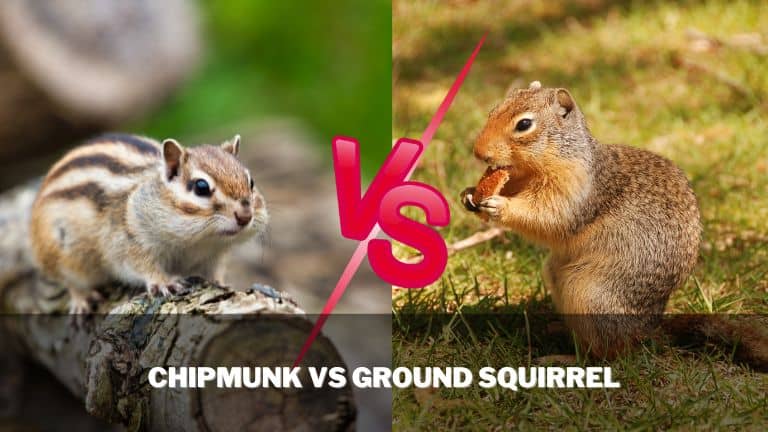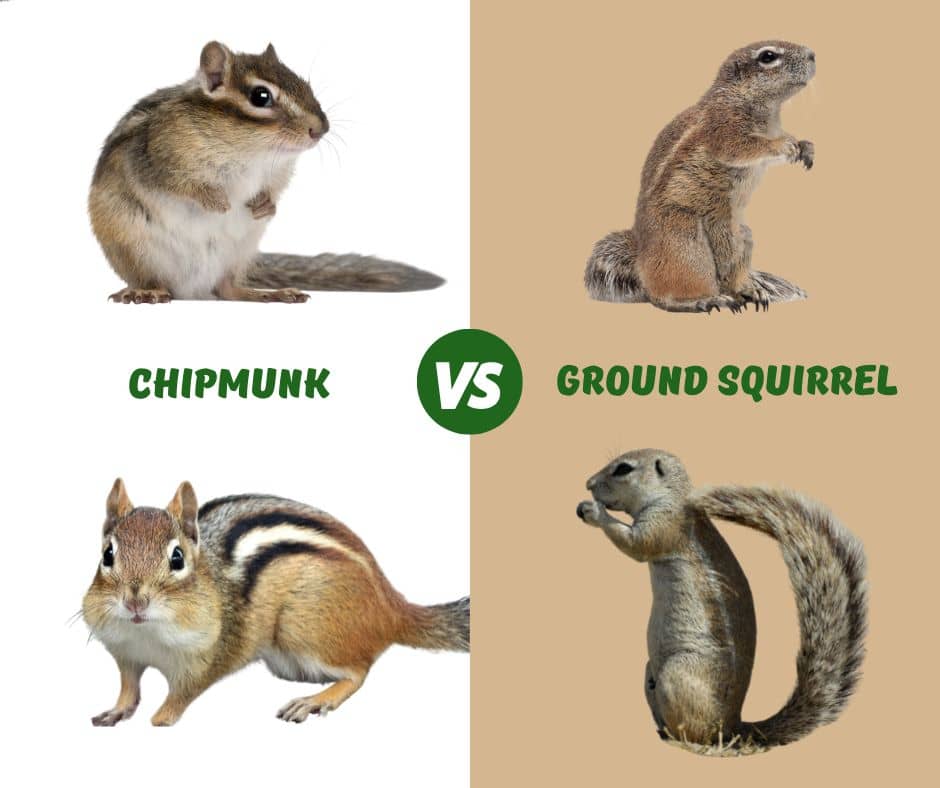It’s natural to get confused when seeing similar creatures, especially chipmunks and ground squirrels. To identify the difference, you’ll need a chipmunk vs ground squirrel argument.
Technically, both of them differ in length, weight, fur shade, color, tail length & look, food habit, lifespan, habitat, and so on. Apart from these, they have dissimilar shapes of ears. And, if you look with your eagle eyes at pictures or live views, it’ll be easy to spot the differences.
In this guide, I’ll break down all the differential points between these two animals. Keep On Reading to Find More…

Comparing Chipmunk Vs Ground Squirrel Characteristics
Even if they are from the same family (Sciuridae), both of them differ in 9 different sectors. Here’s a sneak peek of the comparison point in the table:
| Traits | Ground Squirrel | Chipmunk |
| Length | 7.2” to 30” | 6.2” to 12” |
| Weight | 41 to 11,000 grams | 25 to 150 grams |
| Ear Shape | Erect and conspicuous | Round and erect |
| Fur Shade | Mottled brown fur | Reddish brown fur |
| Tail Length | 2.4” to 4.4” | 3” to 4” |
| Tail Appearance | Semi-bushy | Hairy |
| Food Habit | Eat plants and animals | Mostly consume veggies |
| Color Of Hair | Light brown, gray, and white with no stripe | Tan, light brown, black stripes, and reddish stripes |
| Lifespan | In the wild, 3 to 6 years and 10 years in captivity | In the wild, 2 to 3 years and 11 years in captivity |
| Habitat | Open and grassy areas | Forests, thick brushes, meadows, fields, bird feeders, gardens, and trees |
| Speed | 15 MPH | 21 MPH |
1. Body Size & Weight
Ground squirrels are usually bigger than chipmunks both in weight and size. They are around 18 to 76 cm (7.2” to 30”) in body length and weight of up to 0.09 to 24 lbs. (41 to 11,000 grams).
On the other hand, chipmunks have a diverse range based on their types. To understand it clearly, look at the given points:
- Eastern Chipmunks
- Body Length: 30 cm (12”) including the tail
- Weight: 0.146 to 0.331 lbs. (66 to 150 grams)
- Common Chipmunks
- Body Length: 18 to 25 cm (7.1” to 9.8”)
- Weight: 0.110 to 0.331 lbs. (50 to 150 grams)
- Least Chipmunk
- Body Length: 15.7 to 25 cm (6.2” to 9.8”)
- Weight: 0.0551 to 0.146 lbs. (25 to 66 grams)
2. Ear Shape
The ear of ground squirrels and chipmunks vary a lot which you can see from afar. The ground squirrels contain erect and conspicuous ears while the chipmunks have round and erect ears.
3. Style of Fur
Looking at the fur of animals, you can easily locate the diversity easily. The ground squirrels have mottled brown fur which is filled with white and gray shade in tiny marks on the backside.
Unlike them, the chipmunks contain reddish brown fur (short yet thick) which is striped with black and white hairs. Plus, their furs look the brightest shade on the rump and flanks.
4. Tail Length & Looks
You can easily spot the contrasting point between these two creatures if analyze their tail height and appearance. The tail of ground squirrels is 6 to 11.2 cm (2.4” to 4.4”) in length which looks semi-bushy.
Then again, the chipmunks contain a 7.62 to 10.16 cm (3” to 4”) long tail that looks hairy, not thick or bushy.
5. Food Habit
Both animals have remarkably diverse food habits compared to each other. The ground squirrels are born omnivorous (eat plants and animals).
They survive by consuming a rich diet like fungi, fruits, nuts, and seeds. Sometimes they eat insects, eggs, and tiny creatures such as mice and rats.
In opposition, the chipmunks are mostly vegetarian. They eat grains, berries, pumpkins, mushrooms, sunflower seeds, and other tender plants.
However, the chipmunks consume non-veggie foods like worms, frogs, mice, small birds, and snakes. Using these foods is how to lure a chipmunk out of hiding, as an effective option.
6. Color of Hair
In the body of ground squirrels, you’ll spot a combination of light brown, gray, and white color hairs with no stripe. Some of them can have white rings (round) around the eye.
The body hair of chipmunks contains 2 tans with 5 long black stripes on the back area. In the face areas, they have 2 tan and 2 light brown stripes on both sides. On the end area (rump), you’ll locate long reddish stripes.
7. Lifespan
The lifespan of these two animals is pretty close. Ground squirrels can live for up to 3 – 6 years in wildlife. However, they survive 10 years in captivity lifestyle.
On the contrary, chipmunks last for 2 to 3 years in the wild lifestyle. However, they survive longer than ground squirrels in captivity for up to 11 years on average.
8. Habitat
In general, ground squirrels live in either open or grassy areas. They make their small dens in rocky outcrops, fields, pastures, sparsely wooden surfaces, parts, and so on.
In comparison to them, the chipmunks live in forests, thick brush, meadows, fields, around fences, bird feeders, and so on.
They usually aim for locations where food is enough like gardens. This is where do chipmunks nest are made.
9. Speed
The last difference between them is the speed. While the chipmunks run at 21 MPH (33 KPH) top speed, the ground squirrels have 15 MPH (24 KPH) top speed.
See The Chipmunk Vs Ground Squirrel Pictures!
After learning the differential points of chipmunks and ground squirrels, it’s time to visually understand their diversity. Let’s dive into it:

Overall Thoughts
A lot of folks think chipmunks and ground squirrels are the same creature although they are different animals. From living to eating habits, both creatures will show diverse natures.
Hope the chipmunk vs ground squirrel topic helps you to differentiate them easily. Have A Wonderful Day!
